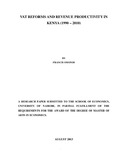| dc.description.abstract | Kenyan government has been faced with constantly increasing development and recurrent
expenditure with limited additional sources of revenue. A number of factors have contributed
to this increase in government expenditures namely; prolonged drought over the years, high
rate of inflation, demands for salary increment, implementation of new constitution among
others. Consequently, the government budget deficit is becoming huge and may be
unsustainable in future. We therefore carried out this study having identified Kanya's VAT as
one of the revenue sources that is not fully utilized to find out whether it can help to generate
additional revenue to the government to help in financing the growing budget deficit.
The approach that this study took was to evaluate VAT reforms that have been undertaken on
VAT since its introduction in 1990 aimed at boosting its revenue generating capacity. We
hoped to identify areas that need further reforms to increase VAT compliance rate which has
been relatively low over the years. We established that Kenya's VAT has been subjected to a
number of reforms since its introduction for instance rationalization of VAT rates and
lowering of VAT ceiling to minimize tax evasion and to increase competitiveness of local
products together with other reforms discussed in this paper.
To estimate the revenue productivity of VAT, we used elasticity and buoyancy models. VAT
buoyancy was estimated using actual VAT data which did not require to be adjusted for
government discretionary tax measures. On the other hand, data used to estimate VAT
elasticity had to be adjusted using proportional adjustment method (PAM) to eliminate
changes in VAT revenue occasioned by discretionary tax policy measure taken to boost VAT
revenue.
The study found Kenya's VAT to be inelastic and non-buoyant, with elasticity and buoyancy
coefficients being less than unity. This confirmed that the VAT as a source of revenue is
grossly underperforming and there is need for further reforms on VAT to boost its revenue
productivity. We therefore proposed a number of policy measures to be undertaken to
increase revenue generating capacity of Kenya's VAT. | en_US |

